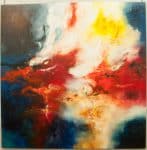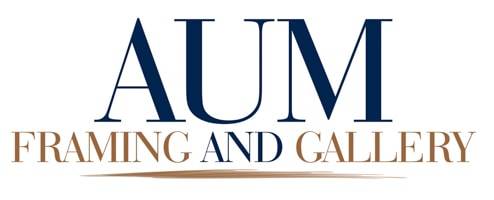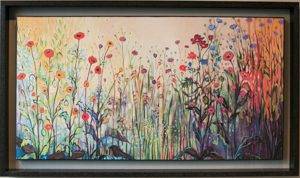You’ve purchased a canvas that’s rolled up and you’re wondering how to display it on your wall. Whether it’s original art that was painted onto the canvas or a giclee (a digital image printed on the canvas), the first step is to have it professionally stretched.
Canvas stretching 101
Canvas stretching is the term used for attaching a canvas to wood bars so that it can be framed or hung without a frame. The process also helps preserve the canvas art. There are a couple of alternatives to canvas stretching (dry mount or wet mount) but stretching is normally the best alternative and the vast majority of canvases are stretched for display.
Stretcher Bar or Strainer Bar?
In the old days canvases were stretched on stretcher bars.
The canvas was stretched over the bars and fastened with copper tacks (since they didn’t rust and stainless steel didn’t exist). This is an example of an old French stretcher bar with the 2 keys in each corner. The keys are used to tighten the canvas in either direction if needed. We’ll still use stretcher bars if we’re working with an old canvas but most stretching these days is done on strainer bars. Instead of copper tacks we use staples.
Strainer bars are mitred and joined just like a regular frame and aren’t adjustable once they’re built.
Strainer bars are not completely flat – they normally have a rounded, raised lip on the outside which keeps the stretched canvas from touching the majority of the bar. If it didn’t, a line would appear on the canvas where it touched the bar.
Strainer bars come in various sizes and widths and we’ll recommend the correct one based on the size of your canvas. For large canvases we’ll use crossbars to help keep the canvas tight and the strainer bar from warping. We kreg jig our crossbars to maintain rigidity. If you have a large canvas to be stretched make sure, wherever you take it, that they use crossbars.
How large a canvas can AUM stretch?

This abstract canvas we stretched is 5 feet square
Most frame shops can’t stretch a canvas that’s 10 feet or larger because pre-made strainer bar has a maximum length of 10 feet. We have the expertise to stretch almost any length of canvas and typically stretch many canvases over 10 feet every year. We actually build the extra long strainer bars in our onsite wood shop.

Canvas is almost 5 feet x 6 feet
What is Gallery Wrap?
Canvases are fastened to strainers bars in one of two ways. Either stapled to the side or to the rear. Stapling to the rear is called a Gallery Wrap. If you want to display a stretched canvas unframed you should have it stretched with a Gallery Wrap. If you’re going to have the stretched canvas framed have it stapled on the side as the cost is lower and the frame will hide the staples (unless you use a floater frame – see below). Sometimes clients will come into the store with a canvas that has been cut from a stretcher so there’s too little canvas to do a Gallery Wrap without losing some of the image around the back. Don’t worry, we can fix that problem too (most framers can’t).
Framing options for a stretched canvas.
Floater Frame.
A floater frame is like a letter “L”. The bars used to stretch the canvas are attached to the base of the “L” and there is a gap between the side of the canvas and the side of the frame. In addition to pre-finished wood floater frames with various finishes, we can create floaters with custom finishes in both wood and steel.
Regular Frame.
If you want to use a regular frame it must be deep enough to accommodate the height of the stretched canvas. The disadvantage to using a regular frame is that it will cover part of the image where the lip covers it (no more than 1/4 inch and often less). The advantage to a regular frame is that there’s a much larger choice of profiles and finishes.
How to roll a canvas for shipping/transportation.
As long as the paint or ink is COMPLETELY dry, a canvas can be rolled without causing damage to it. ALWAYS roll a canvas with the image on the outside and not the inside. If you’re buying a canvas abroad that is on a stretcher have the artist or vendor pull out the staples or nails to get it off the stretcher. You need to save as much of the canvas outside the image as possible. Never let them cut the canvas off the stretcher as it will cost you more when you have it stretched when you get home. If possible, use a non-stick, acid free paper like glassine on top of the image when you roll it. Roll it as loosely as possible and try to find a tube to put it in. If tubes aren’t readily available use brown paper or similar and tape it, don’t tie something around it.
Hopefully we’ve answered most, if not all, of our questions about canvas stretching and framing. If not, please call us at 303-394-3362 or, better still, stop in for a free consultation with one of our designers.
If you’re not familiar with us or our work, we invite you to take a look around our website or, even better, come in and talk to us about your canvas project and we can walk you through the process and offer design tips.
Take a look at some of our recent work on our portfolio page
If you prefer to set up an appointment to come in and talk to one of our designers for a free design session/discussion, please call us at 303-394-3362 . Alternatively, send us an email below with some details of what you’re looking for and we’ll get back to you as quickly as we can.
Email us



